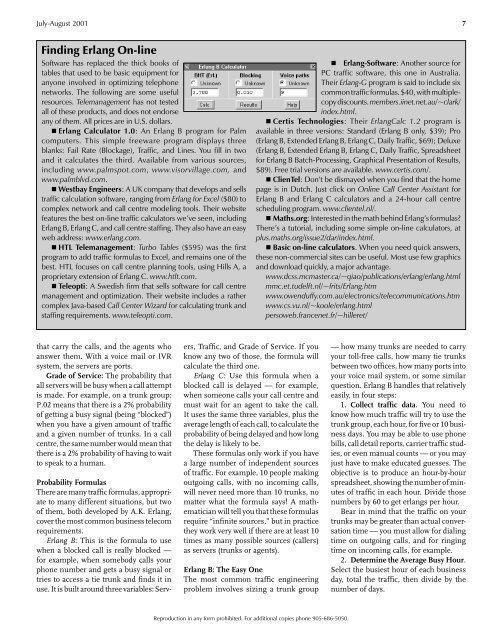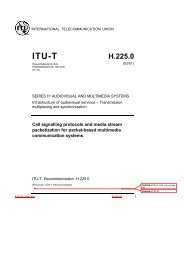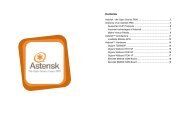An Introduction to Erlang B and Erlang C - VOIP Information
An Introduction to Erlang B and Erlang C - VOIP Information
An Introduction to Erlang B and Erlang C - VOIP Information
You also want an ePaper? Increase the reach of your titles
YUMPU automatically turns print PDFs into web optimized ePapers that Google loves.
July-August 2001 7Finding <strong>Erlang</strong> On-lineSoftware has replaced the thick books oftables that used <strong>to</strong> be basic equipment foranyone involved in optimizing telephonenetworks. The following are some usefulresources. Telemanagement has not testedall of these products, <strong>and</strong> does not endorseany of them. All prices are in U.S. dollars.! <strong>Erlang</strong> Calcula<strong>to</strong>r 1.0: <strong>An</strong> <strong>Erlang</strong> B program for Palmcomputers. This simple freeware program displays threeblanks: Fail Rate (Blockage), Traffic, <strong>and</strong> Lines. You fill in two<strong>and</strong> it calculates the third. Available from various sources,including www.palmspot.com, www.visorvillage.com, <strong>and</strong>www.palmblvd.com.! Westbay Engineers: A UK company that develops <strong>and</strong> sellstraffic calculation software, ranging from <strong>Erlang</strong> for Excel ($80) <strong>to</strong>complex network <strong>and</strong> call centre modeling <strong>to</strong>ols. Their websitefeatures the best on-line traffic calcula<strong>to</strong>rs we’ve seen, including<strong>Erlang</strong> B, <strong>Erlang</strong> C, <strong>and</strong> call centre staffing. They also have an easyweb address: www.erlang.com.! HTL Telemanagement: Turbo Tables ($595) was the firstprogram <strong>to</strong> add traffic formulas <strong>to</strong> Excel, <strong>and</strong> remains one of thebest. HTL focuses on call centre planning <strong>to</strong>ols, using Hills A, aproprietary extension of <strong>Erlang</strong> C. www.htlt.com.! Teleopti: A Swedish firm that sells software for call centremanagement <strong>and</strong> optimization. Their website includes a rathercomplex Java-based Call Center Wizard for calculating trunk <strong>and</strong>staffing requirements. www.teleopti.com.! <strong>Erlang</strong>-Software: <strong>An</strong>other source forPC traffic software, this one in Australia.Their <strong>Erlang</strong>-G program is said <strong>to</strong> include sixcommon traffic formulas. $40, with multiplecopydiscounts. members.iinet.net.au/~clark/index.html.! Certis Technologies: Their <strong>Erlang</strong>Calc 1.2 program isavailable in three versions: St<strong>and</strong>ard (<strong>Erlang</strong> B only, $39); Pro(<strong>Erlang</strong> B, Extended <strong>Erlang</strong> B, <strong>Erlang</strong> C, Daily Traffic, $69); Deluxe(<strong>Erlang</strong> B, Extended <strong>Erlang</strong> B, <strong>Erlang</strong> C, Daily Traffic, Spreadsheetfor <strong>Erlang</strong> B Batch-Processing, Graphical Presentation of Results,$89). Free trial versions are available. www.certis.com/.! ClienTel: Don’t be dismayed when you find that the homepage is in Dutch. Just click on Online Call Center Assistant for<strong>Erlang</strong> B <strong>and</strong> <strong>Erlang</strong> C calcula<strong>to</strong>rs <strong>and</strong> a 24-hour call centrescheduling program. www.clientel.nl/.! Maths.org: Interested in the math behind <strong>Erlang</strong>’s formulas?There’s a tu<strong>to</strong>rial, including some simple on-line calcula<strong>to</strong>rs, atplus.maths.org/issue2/dar/index.html.! Basic on-line calcula<strong>to</strong>rs. When you need quick answers,these non-commercial sites can be useful. Most use few graphics<strong>and</strong> download quickly, a major advantage.www.dcss.mcmaster.ca/~qiao/publications/erlang/erlang.htmlmmc.et.tudelft.nl/~frits/<strong>Erlang</strong>.htmwww.owenduffy.com.au/electronics/telecommunications.htmwww.cs.vu.nl/~koole/erlang.htmlpersoweb.francenet.fr/~hilleret/that carry the calls, <strong>and</strong> the agents whoanswer them. With a voice mail or IVRsystem, the servers are ports.Grade of Service: The probability thatall servers will be busy when a call attemptis made. For example, on a trunk group:P.02 means that there is a 2% probabilityof getting a busy signal (being “blocked”)when you have a given amount of traffic<strong>and</strong> a given number of trunks. In a callcentre, the same number would mean thatthere is a 2% probability of having <strong>to</strong> wait<strong>to</strong> speak <strong>to</strong> a human.Probability FormulasThere are many traffic formulas, appropriate<strong>to</strong> many different situations, but twoof them, both developed by A.K. <strong>Erlang</strong>,cover the most common business telecomrequirements.<strong>Erlang</strong> B: This is the formula <strong>to</strong> usewhen a blocked call is really blocked —for example, when somebody calls yourphone number <strong>and</strong> gets a busy signal ortries <strong>to</strong> access a tie trunk <strong>and</strong> finds it inuse. It is built around three variables: Servers,Traffic, <strong>and</strong> Grade of Service. If youknow any two of those, the formula willcalculate the third one.<strong>Erlang</strong> C: Use this formula when ablocked call is delayed — for example,when someone calls your call centre <strong>and</strong>must wait for an agent <strong>to</strong> take the call.It uses the same three variables, plus theaverage length of each call, <strong>to</strong> calculate theprobability of being delayed <strong>and</strong> how longthe delay is likely <strong>to</strong> be.These formulas only work if you havea large number of independent sourcesof traffic. For example, 10 people makingoutgoing calls, with no incoming calls,will never need more than 10 trunks, nomatter what the formula says! A mathematicianwill tell you that these formulasrequire “infinite sources,” but in practicethey work very well if there are at least 10times as many possible sources (callers)as servers (trunks or agents).<strong>Erlang</strong> B: The Easy OneThe most common traffic engineeringproblem involves sizing a trunk group— how many trunks are needed <strong>to</strong> carryyour <strong>to</strong>ll-free calls, how many tie trunksbetween two offices, how many ports in<strong>to</strong>your voice mail system, or some similarquestion. <strong>Erlang</strong> B h<strong>and</strong>les that relativelyeasily, in four steps:1. Collect traffic data. You need <strong>to</strong>know how much traffic will try <strong>to</strong> use thetrunk group, each hour, for five or 10 businessdays. You may be able <strong>to</strong> use phonebills, call detail reports, carrier traffic studies,or even manual counts — or you mayjust have <strong>to</strong> make educated guesses. Theobjective is <strong>to</strong> produce an hour-by-hourspreadsheet, showing the number of minutesof traffic in each hour. Divide thosenumbers by 60 <strong>to</strong> get erlangs per hour.Bear in mind that the traffic on yourtrunks may be greater than actual conversationtime — you must allow for dialingtime on outgoing calls, <strong>and</strong> for ringingtime on incoming calls, for example.2. Determine the Average Busy Hour.Select the busiest hour of each businessday, <strong>to</strong>tal the traffic, then divide by thenumber of days.Reproduction in any form prohibited. For additional copies phone 905-686-5050.






